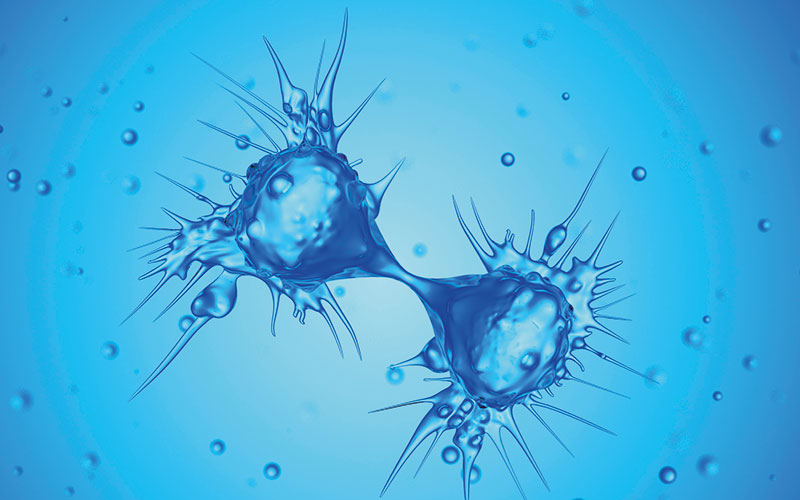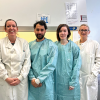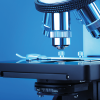Constantinos Koumenis says his new target for cancer may be an important step in progress, but stresses that there is no magic bullet to stop the disease.

In the ongoing fight against cancer, biochemical scientists have made solid progress over the past 20 years. They have isolated many of the mechanisms of the disease, developed new screening techniques and devised more effective treatments, all with the result that survival rates for many types of cancer are now much improved. But rather than making the giant leaps beloved by newspaper headlines, most of these advances have come one small step at a time – and another of those small steps has been taken with the publication in Nature Cell Biology of new research that may have found a way to make certain cancers self-destruct.
The study has emerged from the Perelman School of Medicine of the University of Pennsylvania, where a research team headed by Constantinos Koumenis, professor and research director of radiation oncology, has been working to unlock the secrets of MYC, a gene that has long been associated with tumour growth in a range of cancers.
Prime target
“Like most of the genes that promote cancer, MYC has a regular function in the cell,” says Koumenis. “When it is on it promotes cell growth, and helps cells to divide and proliferate. For example, it has an important role in the developing embryo and in tissue regeneration. However, in cancer it can become over-active by gene amplification, making many copies of itself, and then it stimulates uncontrolled proliferation. But it is not enough to have copies of MYC turning on, as our cells have safeguards to prevent uncontrolled growth when they sense that. So when MYC is on, you also need a second or third factor, and that is sometimes enough to turn a cell into a tumour. We have also known for some years that many cancers have a high copies or higher activity of MYC.”
Naturally, this has made MYC a prime target for research, which has looked to isolate the exact properties of the gene that cause it to malfunction and promote the growth of tumours. But it has so far proved to be a tough nut to crack.
“There is a big problem,” says Koumenis. “For a lot of other targets we have good drugs that target specific proteins. But MYC is different, in that it’s a transcription factor, which binds to the DNA and tells the cell what proteins to make. In that sense it is notoriously difficult to manage. Several scientists and companies have started to develop specific drugs that target MYC by trying to block the interaction of this transcription factor with other factors. Chemically it is a much tougher proposition to inhibit this, so we had to think whether we could disrupt this interaction via other factors.”
Gas pedal and brake
So the hunt was on to find other parts of the mechanism surrounding MYC that might respond more readily to existing drug therapies. Koumenis and his team soon began to observe some interesting effects with another transcription factor, called ATF4. “We found a connection between MYC and this protein. It turns out that this protein acts as a partner to MYC in the cell when MYC is on, and tells the cells to grow, they need fuel, they need amino acids, lipids, nucleotides. Together, MYC and ATF4 turn on a group of about 30 genes that bring that fuel into the cell.”
Even more interestingly, they found that ATF4 also controls another factor, known as 4E-BP, which acts as a brake on cell growth by telling the cell to make less protein. “If MYC is the gas pedal for tumour growth, you need a brake,” says Koumenis, “because with uncontrolled growth, if you can’t get enough fuel, the cells will die. As a consequence, if you have MYC on without ATF4 and 4E-BP, without this brake to moderate the proliferation of tumour cells, the cells cannot actually respond.” In effect, they self-destruct.
Looking at MYC-related mouse tumours, the team saw that when MYC is high, ATF4 and 4E-BP is also high. Working on the assumption that this correlation was causation, they turned on MYC and found that mice with cancer survived much longer with ATF4 turned off compared to those where it was left on.
Inhibit action
A review of human tumour databases revealed the same correlation between MYC, ATF4 and 4E-BP. Human trials to test the concept are the next logical step, but while finding a drug to block MYC directly remains a work in progress, ATF4 is a different matter. One promising drug is being developed by another group, though it is still at the preclinical phase. In the meantime Koumenis and his team are searching various drug libraries for any existing, approved medications that might also inhibit the action of ATF4. “All this is with the grain of salt that we don’t have a suitable drug for humans yet, but the context of our work remains that while we cannot target MYC directly, inhibiting ATF4 may be able to block some of the critical aspects of the MYC biology and so prolong the survival of people with MYC-related cancers.”
The work of Koumenis and his team has been trumpeted in some quarters as a potential major breakthrough in cancer research, even a significant advance towards a “cure”. Is that the way he sees it? “In terms of what we know about the biology of cancer, we are making progress every day,” he says. “But it is important to emphasise that cancer is not a single disease with just one key secret to be cracked. Scientists have made remarkable progress in some types of cancer but barely a dent in others. You can’t generalise. Our work is primarily on the fundamental biology of cancer and, though a small step, we feel that we have identified a promising new target. We think ATF4 is important and in mice we have shown that by blocking its activity in tumours we can prolong life. As for the idea of a cure, we will still be dealing with cancer for years to come. Malignancy is a problem of human biology, of ageing and accumulating mutations. But if we can prolong life or ease suffering for some types of cancer, that is a task worth pursuing.”
Constantinos Koumenis
- 1989: BS (Pharmacy With Honors) Aristotle University, Thessaloniki, Greece
- 1994: PhD (Biochemistry) University Of Houston, Houston, US
- 2006: Professor of Research Oncology, University of Pennsylvania, US.
Image credit | Science Photo Library




